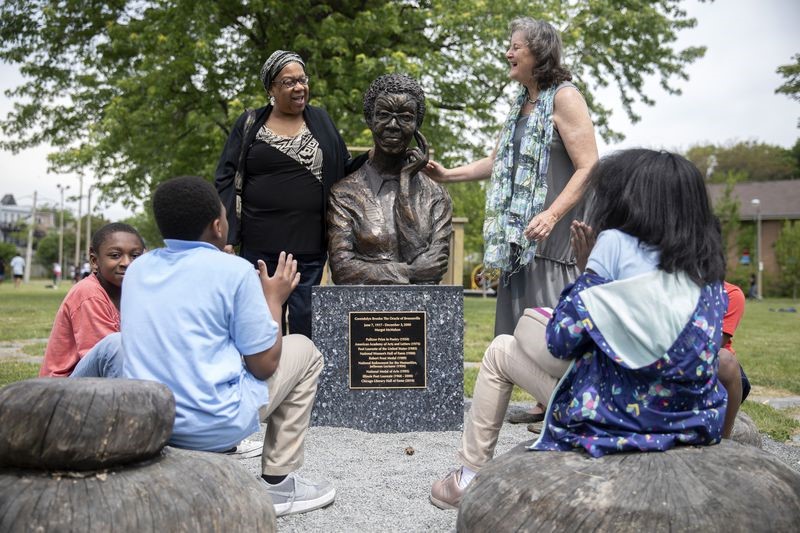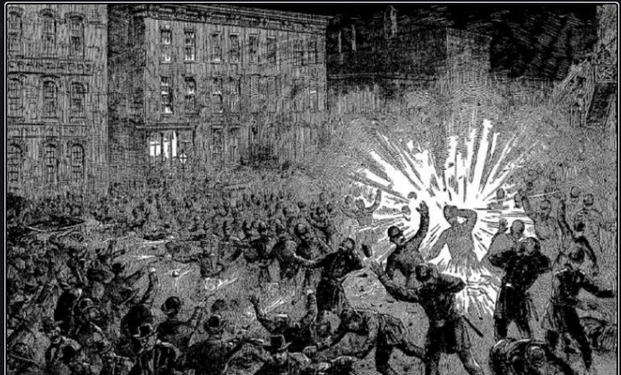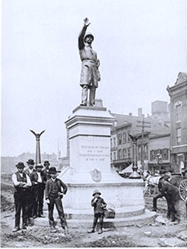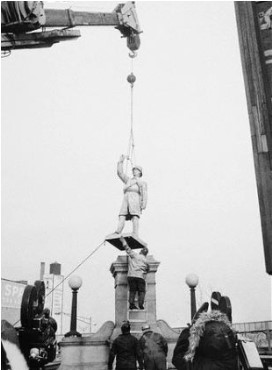Gwendolyn Brooks (1917-2000) was born in Topeka, Kansas, but spent her formative years in Chicago’s south side in Bronzeville, where a bust of her now resides in Brooks Park (4542 S. Greenwood) [1]. Brooks was the first black author to win the Pulitzer Prize with her 1949 poem Annie Allen. In addition to this she was also the first black woman to be a poetry consultant for the Library of Congress [2]. While these accomplishments, and many more, are listed on the Gwendolyn Brooks: Oracle of Bronzeville monument, they are not the most significant. The most striking aspect of the monument is the sense of community that both it and its subject stand for.

The Brooks Park monument is a slightly larger than life size bronze casted bust, depicting Brooks from the waist up. There are five stone seats on the ground, that with the bust form a circle. Behind Brooks is a replica of the front porch of her childhood home. These two elements are connected by a stone pathway leading from the porch to the bust of Brooks. The stones have various quotes from Brooks’ Annie Allen engraved in them in order to give “insight to what it’s like to grow up as a little girl in Bronzeville.” [3] Between the stone pathway that leads up to the monument, the circle of seating, the close to life size depiction of Brooks, and the position of the bust close to the ground, the setup seems to invite viewers to have a conversation with Brooks. Having not been to the monument in person and judging the location and atmosphere solely from the images and videos available online, a single word that could be used to describe the area is community.
The Gwendolyn Brooks: Oracle of Bronzeville monument joined the Chicago monument roster in 2018, just eighteen years after the passing of Brooks, and on what would have been her 101st birthday. What sets this apart from the majority of the other monuments in the city is that it is the only monument in a Chicago public space that depicts a woman for her likeness and depicts a woman of color [4]. In fact, The Oracle of Bronzeville is the first Chicago monument to both honor and depict an African American woman [5]. Brooks continues to make history even after her death.
The monument resides in a park that has been renamed by the Chicago Park District as Brooks Park. However, before the placement of the monument there was no physical reminder of Brooks beyond her name on the sign. This was one of the motivations for the monument [6]. It is unlikely that there could be a more appropriate location for this monument in Chicago. The monument was created with an intention of gathering people to celebrate a community leader in her home neighborhood.
The Chicago Literary Hall of Fame was the main commissioner of and force behind the creation of the statue; however, it was done with the collaboration of the Chicago Park District, the Poetry Foundation, and Brooks Permissions. Another key player in this process was the sculptor, Margot McMahon. McMahon is deeply involved in the Chicago art community. She has various sculptures on display throughout the city and teaches art courses at the School of the Art Institute of Chicago, DePaul University, and at an Oak Park school district [7].
The goal of the artist, Margot McMahon, was to “both educate and invite public interaction”, specifically targeting the younger population in an effort to more fully embody the spirit of Brooks [8]. McMahon “wanted to sculpt her listening to us and giving importance to our stories, like she had for many school children.” [9] In addition to creating her own art, Brooks made a point of supporting the youth of Chicago in their exploration of writing. Her support ranged from publishing the students’ works in books to open mics with prize money [10]. McMahon spent two years working closely with Brooks’ daughter, Nora Brooks Blakely, in order to create as accurate a representation of both Brooks’ physical appearance and spirit as possible [11].
The funding for the monument came from a variety of sources, widening the group of stakeholders. A portion of the funding came from the Chicago Park District via a $2,000 grant [12].

Another source of financial support was found in the public, which resulted in another $5,000 from a GoFundMe page [13]. Turning to the general public for funding greatly increased the number of stakeholders in the equation. There is no immediate negative feedback, nor have there been any reports of vandalism or other destruction. This indicates few disappointments with the project. However, the monument has barely been in place for two years, so time may be a factor. The location of the monument, in the heart of the community where Brooks grew up, also likely plays a significant factor.
Apart from the initial unveiling of the sculpture, there have not been any widely publicized events or community gatherings at the monument. This is likely due to two main factors. The first factor being that the monument is just barely two years old. There simply has not been an ample number of opportunities or events to celebrate in two years. The second reason is that the monument has spent ten months of its two-year existence in a pandemic where traveling and public gatherings have been strongly discouraged. It will be interesting to see how this monument functions within the community over time.
The Bronzeville monument Gwendolyn Brooks: Oracle of Bronzeville aims to both serve as a gathering place for community and inspire creativity. While the design and first two years of the monument’s presence in the community both indicate that it has been successful, it still has lots of time and potential to cultivate community relationships and inspire creativity in many younger generations to come.
Madeleine Lawler, Loyola University Chicago
[1] Poetry Foundation, “Gwendolyn Brooks,” Poetry Foundation, 2017, https://www.poetryfoundation.org/poets/gwendolyn-brooks.
[2] Poetry Foundation.
[3] Ravensvoyage Productions, “Gwendolyn Brooks Sculpture,” ed. Rana Segal, Vimeo, April 12, 2018, https://vimeo.com/264504274.
[4] Lolly Bowean, “On Gwendolyn Brooks’ Birthday, a Statue of the Powerful Poet Will Be Unveiled on the South Side,” chicagotribune.com (Chicago Tribune, June 6, 2018), https://www.chicagotribune.com/news/ct-met-gwendolyn-brooks-statue-20180606-story.html
[5] Chicago Literary Hall of Fame, “CLHOF Installs Sculpture of Gwendolyn Brooks in Brooks Park.,” Chicago Literary Hall of Fame, June 7, 2018, https://chicagoliteraryhof.org/news_entry/178.
[6] Chicago Literary Hall of Fame.
[7] “Margot McMahon: About the Artist,” Margot McMahon, accessed November 20, 2020, https://www.margotmcmahon.com/about.html.
[8] “GWENDOLYN BROOKS,” Statues For Equality, https://statuesforequality.com/pages/gwendolyn-brooks.
[9] Editor, “Gwendolyn Brooks: The Oracle of Bronzeville,” Chicago Defender, June 13, 2018, https://chicagodefender.com/gwendolyn-brooks-honored-with-new-sculpture/.
[10] Chicago Defender.
[11] Ravensvoyage Productions.
[12] Chicago Literary Hall of Fame.
[13] “Gwendolyn Brooks Sculpture Portrait, Organized by Donald G. Evans,” gofundme.com, March 10, 2018, https://www.gofundme.com/f/clhofbrooks.
[14] WWP team, Gwendolyn Brooks: The Oracle of Bronzeville, Wander Women Project, accessed November 20, 2020, https://wanderwomenproject.com/places/gwendolyn-brooks-the-oracle-of-bronzeville/.
[15] Erin Hooley and Chicago Tribune, Gwendolyn Brooks Statue, June 6, 2018, Chicago Tribune, June 6, 2018, https://www.chicagotribune.com/news/ct-met-gwendolyn-brooks-statue-20180606-story.html.



